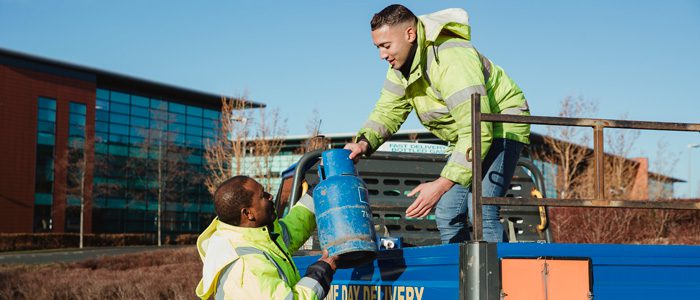How You Can Protect Your Employees From The Texas Heat
In the propane and butane industries, summer is a busy season. While that’s a boost for your business, the unrelenting heat can make it a dangerous time for your employees. Texans who work outdoors or in poorly ventilated environments have an elevated risk for heat-related illnesses — which presents a challenging situation for employers. How do you maintain high safety standards for your workers when temperatures are routinely hitting triple digits?
The solution is planning and preparation, and Texas Mutual Insurance Company can help. We’re safety specialists who know your industry and can assist you in developing a plan for protecting your workers. Our Lone Star Energy Safety Group — created exclusively for propane and butane operators and dealers — provides members with an extensive library of industry-focused safety information and resources.
The following tips are an overview of how to protect your workers — and your business — from the Texas heat.

Awareness
Heat-related illnesses occur when the body can no longer cool itself by sweating, leading to an increase in body temperature. This may result in heat rash, heat cramps, heat exhaustion, and ultimately, heat stroke. Anyone exhibiting symptoms of heat-related illness should drink water, move to a cool or shady location, and be placed under a cool, wet towel. If the condition persists, seek immediate medical help.
Employers should train their workers on how to recognize heat-related illnesses so they can respond promptly if symptoms appear.
Hydration
Keeping your workers hydrated is the most essential step you can take to help ensure their protection in a hot environment. Make sure your outdoor workers:
- Drink plenty of liquids in the 24 hours prior to heat exposure.
- Avoid alcohol, caffeine and sugary drinks, which can contribute to dehydration.
- Drink at least one cup of water every 20 minutes.
Acclimatization
Acclimatization is the body’s natural process of gradual physiological adjustment as it gets used to changes in temperature. The process benefits the body in numerous ways, including increased sweating efficiency, stabilization of circulation, increased blood flow and a lower core temperature and heart rate.
By allowing your outdoor workers to adapt to hotter temperatures over a period of days, you can help ease their seasonal transition. Experienced workers should start with a 50% workload on day one, increasing to 100% by day four. For new workers, start with a 20% workload and increase to 100% over a five-day period.
Protection
Staying cool on the job is challenging, but there are important steps you can take to make the summer more bearable for your workers. Employers should:
- Have water or drinks on hand, and make sure workers drink at least one cup every 20 minutes.
- Have outdoor workers wear hats, sunscreen and light-colored clothing.
- When possible, supply fans, increase airflow and provide access to shade.
- Shield any heat sources, such as machinery or electrical equipment.
- Adjust schedules so that work can begin earlier and have lighter tasks performed during the hottest part of the day.
- Tell workers to follow their doctor’s advice regarding medications that could make them more vulnerable to heat-related illness, and make sure they’re aware of any personal risk factors
As the state’s leading workers’ comp insurance provider, Texas Mutual is committed to helping you get your workers home safe every day. Our Lone Star Energy Safety Group not only provides members with valuable safety resources, it can save you an average of 12% on your workers’ comp premium. Plus, you’ll have the chance to earn double dividends every year. To explore the many benefits of safety group membership, visit the group page at texasmutual.com.
Footer Disclaimer
Dividends are based on performance and are not guaranteed.